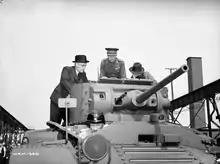Department of Munitions and Supply
The Department of Munitions and Supply was the Canadian federal government ministry responsible for co-ordinating domestic industry during World War II. It was created by the Department of Munitions and Supply Act[1] with C.D. Howe as its Minister.[2] The Department produced armaments for the war effort and regulated the use of gasoline, silk and other strategic commodities in Canada order to prioritize their use for the war production.[2]

Controllers — all of whom were members of the Wartime Industries Control Board — were appointed to regulate the war supply of key industrial sectors, including:
- timber,
- steel,
- other base metals,
- machine tools,
- oil, and
- power.[3]
By the end of the war, Canada's war production ranked fourth among the Allies. By 1945, 70% of Canada's war production went to supply the Allies and only 30% was needed for Canada's own military.[4] Among the production was 815,729 military vehicles, including 45,710 armoured vehicles, many of which went to the British Eighth Army in North Africa and Italy.[4]
_(I0004902).tif.jpg.webp)
The Department established 28 crown corporations[5] including Polymer Corporation that developed and produced synthetic rubber, Victory Aircraft for the production of bombers and Research Enterprises.[2] It coordinated all purchases made in Canada by British and other Allied governments for materials including military transport vehicles, tanks, cargo and military ships, aircraft, guns and small arms, ammunition as well as uniforms, minesweeping equipment, parachutes, firefighting equipment, and hospital supplies.[5]
The Department was dissolved at the conclusion of World War II and most of its crown corporations sold off.[2] The remaining duties of the department were merged with those of the Department of Reconstruction to create the Department of Reconstruction and Supply.[6] In 1951, a new Department of Defence Production was created,[7] with Howe as its minister until 1957. The department itself existed until 1969 when it was abolished and replaced by the Department of Supply and Services.[8]
Further reading
- J.L. Granatstein (May 27, 2005). "Arming the nation: Canada's industrial war effort 1939–1945" (PDF). Ottawa: Canadian Council of Chief Executives.
See also
References
- Department of Munitions and Supply Act, S.C. 3 Geo. VI, c. 3, assented to on September 13, 1939 and proclaimed in force on April 9, 1940.
- Robert Bothwell. "Department of Munitions and Supply". The Canadian Encyclopedia. Archived from the original on 2005-05-22. Retrieved 2008-02-03.
- "Multiplies War Supply Controls". The Globe and Mail. March 10, 1941.
- "The War Economy and Controls: Munitions". Canadian War Museum.
- "Canada's Industries Gear up for War" (PDF). Veterans Affairs Canada.
- S.C. 9-10 Geo. VI, c. 16, assented to on December 18, 1945 and proclaimed in force on January 1, 1946
- S.C. 15 Geo. VI, c. 4, assented to on March 21, 1951 and proclaimed in force on April 1, 1951
- S.C. 17-18 Eliz. II, ch. 28, assented to on March 28, 1969 and in force on April 1, 1969
External links
- "Guide to Canadian Ministries since Confederation". Privy Council Office. Archived from the original on July 24, 2013. Retrieved August 13, 2013.
- "Records relating to the Department of Munitions and Supply". Library and Archives Canada. Retrieved August 13, 2013.